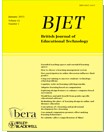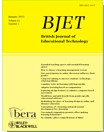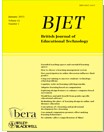-
基础教育
- 教材:
-
- 全部
- 中国地图出版社
- 人教版
- 人教版2012
- 人教版2013版
- 人教版PEP(3年级)
- 人教版义务
- 人教版新课标
- 人教版新起点(1年级)
- 人教版(Go for it)
- 人教版(三年级起点)
- 人教版(三年级起点)2012-2013
- 人教版(版本不明)
- 人教社2016年新编教材
- 冀教版
- 冀教版(三年级起点)
- 北京版
- 北师大版
- 北师大版(2016)
- 北师大版(1年级)
- 北师大版(3年级)
- 北师版2013
- 华东师大版
- 外研社版
- 外研社(三年级起点)
- 外研社(广西专用)
- 广州新版(三年级起点)
- 广州版
- 开心学英语
- 教育科学(3年级起点)
- 教育科学(广州版)
- 新华东师大版
- 新起点英语
- 朗文英语
- 河北版
- 湘少版(3年级起点)
- 牛津上海版
- 牛津上海版(深圳新版)
- 牛津英语
- 粤教版
- 苏教版
- 语文S版
- 语文版
- 首师大版
- 香港现代版
- 齐齐学英语
- 高等教育
- 职业教育
-
Critical Thinking and Learning – Edited 普通类
collomquium
-
Academic Writing and Publishing – By James Hartley 普通类
colloquium
-
The effect of different representations reading 普通类
colloquium
-
A rubric for learning environments 普通类
Colloquium
-
Analysis of the supporting websites 普通类
This paper identifies resources to be included in a website designed to facilitate the integration of instructional games in K-12 settings. Guidelines and supporting components are based on a survey of K-12 educators who are integrating games, an analysis of existing instructional game websites, and summaries of literature on the use of educational software in K-12 settings and teacher technology training. The results indicate that educators face three main challenges when integrating games, including: (1) curriculum integration, (2) technical and logistical requirements, and (3) teacher training. To overcome these challenges, K-12 educators should be provided with: (1) curriculum resources, (2) game technical information and support, and (3) communication tools.Websites designed to facilitate the use of instructional games should be designed with appropriate structures (ie, grid, web, hierarchy) to optimise organisation and simplicity. In addition, the websites should include teacher training that (1) apply a teacher training model, (2) address National Educational Technology Standards, (3) present contents in small doses, (4) make training and information as accessible as possible, and (5) model and mentor the use of instructional games.
-
‘Mind the gap’: An empirical study of the gap 普通类
While numerous previous studies have focused on the use of some corporate e-learning programmes (CELP), little is known about the difference between users’ pre-installation reactions to CELP and user’s post-installation reactions to CELP. This study narrows the above gap with two investigations into a financial company’s CELP. In the pre-installation phase, we surveyed users’ need for cognition, attitudes towards corporate e-learning and intentions for the use of corporate e-learning (INT) in relation to the CELP. Ten months after the installation, we conducted a second investigation to examine learning outcomes on the basis of users’ perceptions of CELP utility, CELP satisfaction, affective reaction to CELP and the actual CELP usage (UGE).We examined the proposed model with multiple regression analyses and found a gap between INT and UGE. The second investigation identified potential factors that contributed to the differences in UGE between two groups of high-INT learners. Results indicated that time management and technical problems were the two critical factors that led to UGE differences. Findings of this study can illuminate relationships among learners’ attitudes, usage and reaction towards the CELP.
-
Exploring the effects of gender and style 普通类
Computer programming has been taught in secondary schools for more than two decades. However, little is known about how students learn to program. From the curriculum implementation perspectives, learning style helps address the issue of learner differences, resulting in a shift from a teachercentred approach to a learner-focused approach. This study aims to investigate the effects of gender and learning styles on computer programming performance. The Gregorc Style Delineator (GSD) was employed to measure learning styles. A test was administered to assess students’ programming performance. Two hundred and seventeen secondary school students of age from 14 to 19 participated in this study. Results indicated that no gender differences in programming performance were found after controlling for the effect of student ability. Academic ability had a differential effect on programming knowledge. Sequential learners in general performed better than random learners. These results suggest the importance of the ordering dimension of the GSD in influencing programming performance. Implications of the findings in relation to programming pedagogy are discussed in this paper.
-
The impact of mobile learning on learning 普通类
Chinese classrooms, whether on school grounds or online, have long suffered from a lack of interactivity. Many online classes simply provide recorded instructor lectures, which only reinforces the negative effects of passive nonparticipatory learning. At Shanghai Jiaotong University, researchers and developers actively seek technologic interventions that can greatly increase interactivity in large blended classes. They developed a cutting-edge mobile learning system that can deliver live broadcasts of real-time classroom teaching to students with mobile devices. Their system allows students to customise means of content-reception based on when and where they tune into the broadcast. The system also supports short text messaging and instant polls. Through these venues, students can ask questions and make suggestions in real time, and the instructor can address them immediately. This article describes this system in detail, and also reports results from a formal implementation of the system in a blended English classroom of 1000 students (with about 800 being online). As the data reveal, m-learning activities can much better engage students in the learning process. Students in this class changed from passive learners to truly engaged learners who are behaviourally, intellectually and emotionally involved in their learning tasks.
-
Evaluating the quality of e-learning 普通类
This paper reports on the development of a scale for determining the quality of the student e-learning experience at the degree level when the student learning context is predominately a campus-based experience. Rapid developments in the use of information and communication technologies (ICT) in higher education require methods for evaluating the contribution of such tools to student learning, especially when they are complementing a face-to-face experience. We examine the psychometric functioning of a proposed e-learning scale in relation to a well-validated degree-level teaching evaluation instrument, the Student Course Experience Questionnaire. The e-learning scale has suitable reliability and validity in the present sample of undergraduate students for quality assurance activities around ICT.










